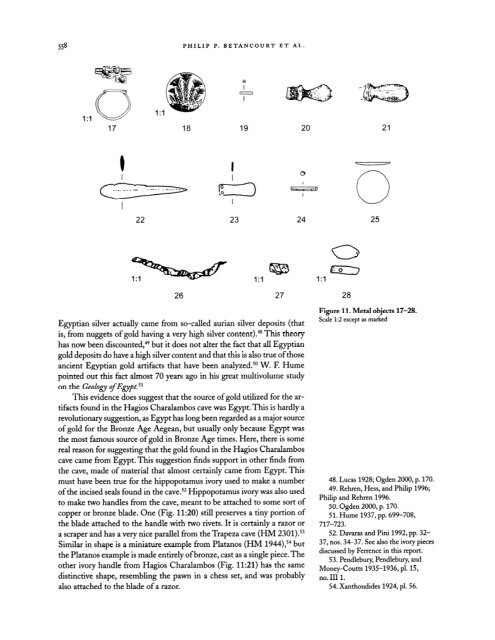Download - The American School of Classical Studies at Athens
Download - The American School of Classical Studies at Athens
Download - The American School of Classical Studies at Athens
You also want an ePaper? Increase the reach of your titles
YUMPU automatically turns print PDFs into web optimized ePapers that Google loves.
558<br />
PHILIP P. BETANCOURT ET AL.<br />
Egyptian silver actually came from so-called aurian silver deposits (th<strong>at</strong><br />
is, from nuggets <strong>of</strong> gold having a very high silver content).48 This theory<br />
has now been discounted,49 but it does not alter the fact th<strong>at</strong> all Egyptian<br />
gold deposits do have a high silver content and th<strong>at</strong> this is also true <strong>of</strong> those<br />
ancient Egyptian gold artifacts th<strong>at</strong> have been analyzed.50 W. F. Hume<br />
pointed out this fact almost 70 years ago in his gre<strong>at</strong> multivolume study<br />
on the Geology <strong>of</strong> Egypt51<br />
This evidence does suggest th<strong>at</strong> the source <strong>of</strong> gold utilized for the ar-<br />
tifacts found in the Hagios Charalambos cave was Egypt. This is hardly a<br />
revolutionary suggestion, as Egypt has long been regarded as a major source<br />
<strong>of</strong> gold for the Bronze Age Aegean, but usually only because Egypt was<br />
the most famous source <strong>of</strong> gold in Bronze Age times. Here, there is some<br />
real reason for suggesting th<strong>at</strong> the gold found in the Hagios Charalambos<br />
cave came from Egypt. This suggestion finds support in other finds from<br />
the cave, made <strong>of</strong> m<strong>at</strong>erial th<strong>at</strong> almost certainly came from Egypt. This<br />
must have been true for the hippopotamus ivory used to make a number<br />
<strong>of</strong> the incised seals found in the cave.52 Hippopotamus ivory was also used<br />
to make two handles from the cave, meant to be <strong>at</strong>tached to some sort <strong>of</strong><br />
copper or bronze blade. One (Fig. 11:20) still preserves a tiny portion <strong>of</strong><br />
the blade <strong>at</strong>tached to the handle with two rivets. It is certainly a razor or<br />
a scraper and has a very nice parallel from the Trapeza cave (HM 2301).53<br />
Similar in shape is a mini<strong>at</strong>ure example from Pl<strong>at</strong>anos (HM 1944),54 but<br />
the Pl<strong>at</strong>anos example is made entirely <strong>of</strong> bronze, cast as a single piece. <strong>The</strong><br />
other ivory handle from Hagios Charalambos (Fig. 11:21) has the same<br />
distinctive shape, resembling the pawn in a chess set, and was probably<br />
also <strong>at</strong>tached to the blade <strong>of</strong> a razor.<br />
Figure 11. Metal objects 17-28.<br />
Scale 1:2 except as marked<br />
48. Lucas 1928; Ogden 2000, p. 170.<br />
49. Rehren, Hess, and Philip 1996;<br />
Philip and Rehren 1996.<br />
50. Ogden 2000, p. 170.<br />
51. Hume 1937, pp. 699-708,<br />
717-723.<br />
52. Davaras and Pini 1992, pp. 32-<br />
37, nos. 34-37. See also the ivory pieces<br />
discussed by Ferrence in this report.<br />
53. Pendlebury, Pendlebury, and<br />
Money-Coutts 1935-1936, pl. 15,<br />
no. Ill 1.<br />
54. Xanthoudides 1924, pl. 56.
















